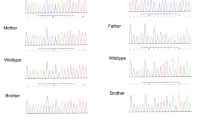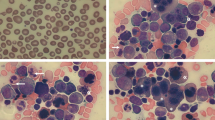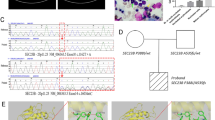Abstract
Congenital dyserythropoietic anemias (CDAs) are a group of hereditary disorders characterized by ineffective erythropoiesis and distinct morphological abnormalities of erythroblasts in the bone marrow. Most cases of CDA, caused by a wide spectrum of mutations, have been reported from Europe and Mediterranean countries, while a few cases have been described in China. Here, we present three cases of CDA, one from one family and two from a second unrelated family, with typical morphologic features and clinical presentations. Sequence analysis of CDA-related genes revealed that the proband with CDA Ι in the first family was a compound heterozygote of CDAN1 with mutation IVS-12+2T>C and c. 3389C>T, while both probands with CDA ΙΙ in the second family were a homozygote of the SEC23B gene with mutation c.938G>A (R313H). This study suggests that more patients with CDA, sharing a phenotype and genetic background like those of European and Mediterranean origin, remain to be diagnosed and reported in China.



Similar content being viewed by others
References
Iolascon A, Esposito MR, Russo R (2012) Clinical aspects and pathogenesis of congenital dyserythropoietic anemias: from morphology to molecular approach. Haematologica 97:1786–1794
Liljeholm M, Irvine AF, Vikberg AL et al (2013) Congenital dyserythropoietic anemia type III (CDA III) is caused by a mutation in kinesin family member, KIF23. Blood 6(121):4791–4799
Heimpel H, Matuschek A, Ahmed M et al (2010) Frequency of congenital dyserythropoietic anemias in Europe. Eur J Haematol 85:20–25
Singh KI, Shartsho JT, Singh WR et al (2007) Congenital dyserythropoietic anemia type II—a case report of two siblings in a family. Indian J Hematol Blood Transfus 23:116–118
Kawabata H, Doisaki S, Okamoto A et al (2012) A case of congenital dyserythropoietic anemia type 1 in a Japanese adult with a CDAN1 gene mutation and an inappropriately low serum hepcidin-25 level. Intern Med 51:917–920
Szeto SC, Ng CS (1986) A case of congenital dyserythropoietic anemia in a male Chinese. Pathology 18:165–168
Ru YX, Zhu XF, Yan WW et al (2008) Congenital dyserythropoietic anemia in a Chinese family with a mutation of the CDAN1-gene. Ann Hematol 87:751–754
Liu G, Niu S, Dong A et al (2012) A Chinese family carrying novel mutations in SEC23B and HFE2, the genes responsible for congenital dyserythropoietic anaemia II (CDA II) and primary iron overload, respectively. Br J Haematol 158:143–145
Yongxin Ru (2013). Current situation of congenital dyserythropoietic anemia diagnosis in a China. J Clin Hematol (in press)
Heimpel H, Forteza-Vila J, Queisser W et al (1971) Electron and light microscopic study of the erythropoiesis of patients with congenital dyserythropoietic anemia. Blood 37:299–310
Dgany O, Avidan N, Delaunay J et al (2002) Congenital dyserythropoietic anemia type I is caused by mutations in codanin-1. Am J Hum Genet 71:1467–1474
Iolascon A, Russo R, Delaunay J (2011) Congenital dyserythropoietic anemias. Curr Opin Hematol 18:146–151
Crookston JH, Crookston MC, Burnie KL et al (1969) Hereditary erythroblastic multinuclearity associated with a positive acidified-serum test: a type of congenital dyserythropoietic anaemia. Br J Haematol 17:11–26
Iolascon I, D'Agostaro G, Perrotta S et al (1996) Congenital dyserythropoietic anemia type II: molecular basis and clinical aspect. Haematologica 81:543–559
Wong KY, Hug G, Lampkin BC (1972) Congenital dyserythropoietic anemia type II: ultrastructural and radioautographic studies of blood and bone marrow. Blood 39:23–30
Schwarz K, Iolascon A, Verissimo F et al (2009) Mutations in the human secretory COPII coat component SEC23B cause congenital dyserythropoietic anemia type II (CDA II). Nat Gen 41:936–940
Bianchi P, Fermo E, Vercellati C et al (2009) Congenital dyserythropoietic anemia type II (CDAII) is caused by mutations in the SEC23B gene. Hum Mutat 30:1292–1298
Iolascon A, Russo R, Esposito MR et al (2010) Molecular analysis of forty two CDA II patients: New mutations in the SEC23B gene and a search for a genotype-phenotype relationship. Haematologica 95:708–715
Fermo E, Bianchi P, Notarangelo LD et al (2010) CDA II presenting as hydrops foetalis: molecular characterization of two cases. Blood Cells Mol Dis 45:20–22
Russo R, Esposito MR, Asci R et al (2010) Mutational spectrum in congenital dyserythropoietic anemia type II: identification of 19 novel mutations in SEC23B gene. Am J Hematol 85:915–920
Conflict of interest
The authors have no potential conflicts of interest, including specific financial interests, relationships, or affiliations relevant to the subject of this manuscript.
Ethical standards
All procedures followed were in accordance with the ethical standards of the responsible committee on human experimentation (institutional and national) and with the Helsinki Declaration of 1975, as revised in 2008 (5). Informed consent has been obtained from all patients for being included in the study.
Author information
Authors and Affiliations
Corresponding author
Rights and permissions
About this article
Cite this article
Ru, Y., Liu, G., Bai, J. et al. Congenital dyserythropoietic anemia in China: a case report from two families and a review. Ann Hematol 93, 773–777 (2014). https://doi.org/10.1007/s00277-013-1933-8
Received:
Accepted:
Published:
Issue Date:
DOI: https://doi.org/10.1007/s00277-013-1933-8




